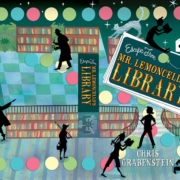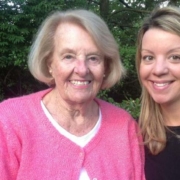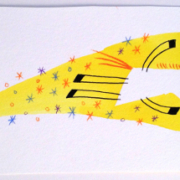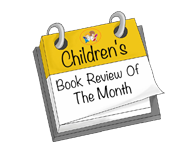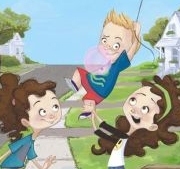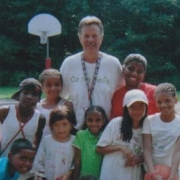Enjoy the latest review for your family by Foundling friend, Celia McGee!
AGES 12 AND UP
The Darkest Path, by Jeff Hirsch. Scholastic Press
America is at war with itself in bestselling author Jeff Hirsch’s new book. Sometime in the near future, it is split into the Federalist states (mostly north). But for the war raging on its perimeters, is not unlike the country we live in now. The rest of the country is controlled by the Glorious Path, a rigid, fundamentalist, and violently oppressive sect that has spread insinuated itself into every aspect of its adherents lives. It is reminiscent of many fundamentalist religions encountered today, whether Christian or other, but taken to extremes in such matters, for instance, of conversion. Though this is kept from the general population—where women must wear long white dresses and veil their faces—if captured enemies refuse to make “The Choice,” they are slaughtered on site. Taken prisoner, 15-year-old Cal and his younger brother, James, have reluctantly opted for The Chjoice in the hopes of achieving full citizenship and then escaping, and carefully drone The Path’s war-feeding prayer: “I am a blade in the hand of God….” But the brothers ultimately find themselves in a civil war of their own. After a first, unsuccessful escape attempt, they are re-captured: Cal goes again for escape, but James, brainwashed by The Path, choses to stay. Cal is eventually aided in his terrifying attempts to reach home—in a nod to the Odyssey, his hometown is Ithaca—by a toughened, brave girl named Nat and her band of Federalist guerillas. The ending to Cal’s tale is complicated, especially because life in the Federalist states is also not perfect—rich people lead decadent, materialistic, empty lives, while the rest must struggle to enjoy a quieter fulfillment. Hirsch captures the ambiguity of well-meaning cults gone wrong and of opposition to them hardened in its own ways.
AGES 8-12
Escape from Mr. Lemoncello’s Library, by Chris Grabstein, Random House
It’s a sad day and a commentary on our fast-paced Internet age when a town’s gorgeous old library has to shut down. What is to be done with an entrancing but empty pile of neo-Gothic beauty? In Chris Grabenstein’s Escape from Mr Lemoncello’s Library (Grabenstein has also been known to collaborate with James Patterson), a stranger comes to the town of Alexandriaville and, under strict secrecy, pours tens of millions of dollars into refurbishing the library inside and out. He’s not a stranger to Kyle Keeley though. He’s Mr. Lemoncello, the most famous designer of board games ever. With a star jock for an older brother and a big-brained younger one, Kyle has so far been unexceptional except for his love of old-fashioned board games. With the library completed, Mr. Lemoncello issues a challenge to the town’s youngsters, with the winner the recipient of a humongous prize. Twelve contestants are chosen through an essay contest, an assorted lot, including a snobbish rich boy who proves Kyle’s prime contender. The only problem is, the challenge is that everyone has to get locked into the library overnight and see who’ll be the first to figure the way out. Forget the library’s 20-ton front door. But, by following certain clues, valuing the right books, figuring out architectural secrets the building harbors, and, ultimately learning the skills of team-building, an escape route may be in the cards. Then a thirteenth player is revealed–Mr. Lemoncello himself, for the convoluted exit game turns out to be a birthday present from his associate, Dr. Zinchenko. He must decipher anagrams, holograms, and hidden passageways with the others. This book is all the more fun because its readers won’t be able to resist playing the game too. The clock is ticking….
AGES 5-8
How to Train a Train, by Jason Carter Eaton, illustrated by John Rocco. Candlewick Press
Here comes—chug-chug, toot-toot–the best pet you’ve never heard of. A train! According to this imaginative book, there are about as many different kinds of trains as there are types of kids who can bond with them. “Freight trains live in the countryside and travel in herds. Monorail trains live in the city and travel alone,” and that’s just for starters. But first you must catch the one your heart desires, and is most in sync with you. The miraculous method cannot be divulged here, just know that when a little girl who favors pink tutus and fairy wings lands her train, for instance, the first step is to name a train—and hers gets fairy wings (big ones), too. Taking care of a pet train is important as well, and somehow, like children, they also need warm, soapy baths. And good habits: they must always wipe their wheels before coming indoors. Children will appreciate that trains have their own doubts and fears, but a good pet owner can help overcome them. The cuddly illustrations in this book make it all the more appealing, and while it’s idea is a new one, the pictures convey a sweet tone of yesteryear. No wonder, thanks to their now thorough upbringing, the pet trains learn to make friends too—pet planes, pet trucks, pet submarines, anyone?
AGES 3-5
How Do Dinosaurs Say I’M MAD? By Jane Yolen and Mark Teague. Blue Sky Press/Scholastic.
The latest in a series of beloved and award-winning dino-books, this one deals humorously with how dinosaurs act out when they’re mad. Both parents and children will recognize certain situations they have had to work through themselves—after all, kids’ emotions can feel dinosaur scale to them, and moms and dads need to know how to put turmoil in the right perspective. As the book opens there are minor infractions caused by anger—a dinosaur sticking out its tongue usually just finds a young human doing it back to him. Due to his size, though, when he expresses himself vocally (that’s called roaring), acts out physically (will the door he just slammed even stay on its hinges, since it certainly scatters toys everywhere?), or dares to yell at Mom and Dad…. Wouldn’t you know that he can pout and grrrrr-umble with the best of them, and give his parents a very scaly cold shoulder. But tearing up his books with his giant claws, just because he’s told to take a nap, and acting even worse when it’s time for bed, that’s just going too far. And a well-brought-up dinosaur knows it, and has a technique for holding his temper as soon as he starts to feel it start to boil up. It’s an easy trick, and will prove valuable to children and their families as they page through this humorous and wise book.

